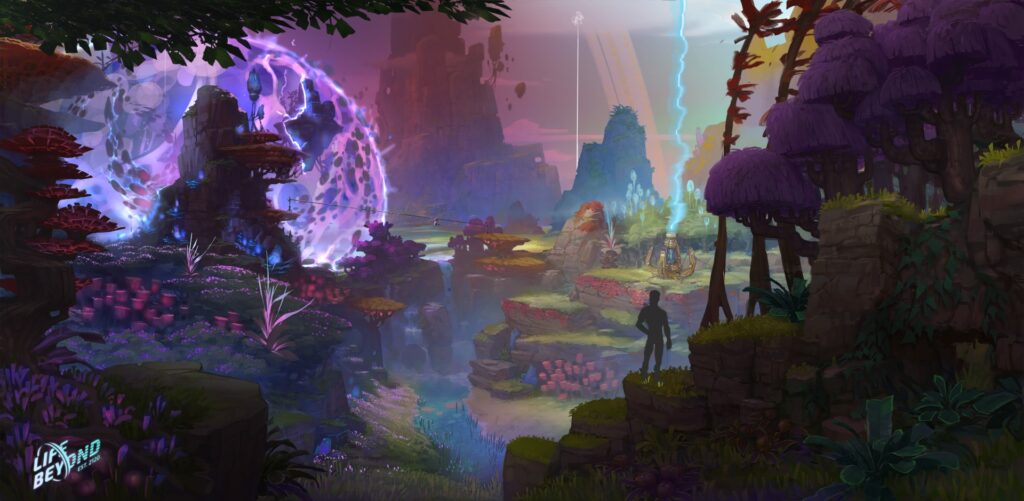The concept of the early access game has become something of an industry staple over the last few years. Once an exciting new trend that changed how we viewed development, it’s now commonly used in even some of the biggest upcoming games.
And yet companies such as Darewise, founded by ex-Ubisoft developers, are choosing to skip early access entirely, in favour of ‘open development’, letting players in even earlier and making them a part of the process – with a real influence on the game’s direction.
Darewise believes that open development is the future for new studios with new IPs. That’s why they currently have thousands of players testing the pre-alpha version of their first game, Life Beyond. Described as “the next-gen social MMO,” Life Beyond is a non-violent game, with a specific focus on teamwork and player choice.
To find out more about open development, we sat down on Zoom with Darewise co-founders Benjamin Cxharbit and Samuel Kahn.
SPOT THE DIFFERENCE

Before we can get to the game itself of course, one thing needs to be made clear. What exactly is the difference between plain-old early access and Darewise’s open development?
“I think it’s really about when you start showing the game to the player,” says Charbit. “If you think about early access, usually you show something that is basically your concept as it will be. Whereas in our case we are being very explicit and saying ‘Hey, we’re not making any promises. What we’re showing now and what we’re working on might change. We might completely overhaul this based on your feedback and on the things that we decide to do.’
“So it’s a matter of trust, and being open with the community. We’re showing something as soon as we technically can, rather than as soon as it’s ready to be shown.”
In that sense, open development provides more freedom to drastically change direction mid-development. Early access games meanwhile, along with their crowdfunded brethren, have already taken the player’s money based on an initial promise – making it much harder to make a big change in direction.
“The very big difference for me is the fact that early access kind of implies that the game needs the revenue to keep going,” Charbit adds. “This is not the case at all with open development. We’re VC funded, it has nothing to do with revenue generation. So it’s really like we’re opening the doors, because we value what you can bring to us. We’ll have some embarrassing moments, it’s fine.”
Opening yourself up to potential embarrassment does seem to be a big risk of open development. Either from a technical nightmare, or to be seen publicly admitting that an initial idea was the wrong call. Darewise must be particularly confident.
“It’s a lot of humility with a lot of confidence,” agrees Charbit, “because we’re not new developers. Some of us have been making games for 10 to 20 years, working on some of the biggest triple-A productions in the world.
“Sam [Kahn] is always very humble, but you’re talking about a guy who built the Snowdrop engine for Massive. He’s one of the key architects of the CryEngine. So obviously, he’s not really concerned that he’s going to be embarrassed publicly because of technical troubles.
“We always have problems like everybody else, because that’s part of game development. Development is not like making a movie, it’s not linear production, it’s super iterative. You review and you challenge your own decisions all the time. But again, you do it with this level of confidence that you still know what you’re doing.”
Charbit makes the point that at the end of the day, it’s about knowing who your game is for. If you’re making a game for your players, it only makes sense that you let them have a say in the game’s development.
“I remember a debate with an old school game designer,” says Charbit. “He was very, very narrow minded and stubborn on a feature, and telling me ‘this is the way it should be, because [I have] 20 years of experience,’ and I was like, ‘but that doesn’t mean anything!’
“You’re not making the game for you. You’re making it for the players. Players are very often more advanced than us, because they play more games and go deeper into the games. They have a very valuable understanding and evaluation of your decisions. So it’s really awesome to be able to get them to give you some feedback. Which is different from asking them what you should do, we’re not asking them to design the game.”
PLAY-VELOPERS

Still, open development games such as Life Beyond are going to appeal to a very specific kind of player. Not only does it need to attract a player base that can accept playing an unpolished pre-alpha version of a game, but one that can roll with significant changes being made throughout its development. So are there concerns about finding and maintaining the right audience?
“I think there’s different kinds of players out there,” says Charbit. “There are players that are interested in games in development, and there are players that really want a polished experience. So if you come to our game today, yes, it’s going to be rough, there’s going to be some issues, there’s going to be some parts that are not finished.
“We’re not scared because we’re talking to an audience that is looking for this kind of stuff. They’re looking for games that are in development. And also because we are not pushing the game to a mass audience quite yet, the people are there because they want to be there.
“And if you’re asking how much can change… I’m going to very quickly summarise. We went from removing PvP, to changing the setting, to changing the art style from hard sci-fi to a kind of youthful, friendly, colourful environment. So anything can change.”
STABLE GROUND
Of course, if you’re changing the game to that extent, you need to be building upon a good foundation. One that can remain stable while still being adaptable to sudden and rapid changes.
“I think one of the big things that I wanted to do when starting a new studio is to do things better and do things differently,” says Kahn. “We worked in the triple-A industry, we’ve seen what massive legacy can do and how that also is a big obstacle really to making games.
“So one of the big things I’m pushing is, essentially, best practices and state of the art processes in the games industry. I strongly believe that the majority of the games industry is made of great people, but working like they were in the garage. If you look at the rest of the development industry, the rest of the world has moved beyond that. We’re talking about people doing 100 per cent test coverage on their code bases. Nobody does that in the games industry.
“So I’m trying to push us to those kinds of standards. The way we develop things is not that we’re trying to hack it, we’re trying to make it right. We’re trying to make it so that it’s modular and reusable, because we’re also planning for two things. One is it’s going to have to be live, so it has to be somewhat stable. And the designers are going to change their mind, so it has to be tolerant.
“We really want to place ourselves as a studio that is a leader on these kinds of best practices. So for example, we’re going to ship a build that is stable, and stable by design. It’s not stable because we worked for a month to stabilise it. If you go to a typical triple-A studio, it’s going to be six to eight months to stabilise the game. And as you know, we’ve had recent examples of that being too short…
“I’m not saying we don’t have bugs, we certainly do have bugs, but we’re prioritising them, and we’re operating more like games as a service. Even if it’s not fully realised, we’re making sure that we take the highest impact bugs, those get fixed. And we make sure that we make progress on our build and show that as often as possible to the players.”
“Basically we’re saying, I want tools to be able to iterate very fast, internally,” adds Charbit. “To empower my design team to make decisions and apply them. So if it takes six months to get a change, which is very often how it works in triple-A, it takes too long.
“So that’s the first thing you need, you need really high quality QA processes to be able to evaluate. It’s basically running things as a software as a service company.
“And then you need to be able to very quickly push this thing out and deploy it on live instances. To get the ability to push your build every two weeks, which is what we have been able to do since last June, basically.”
“What this has definitely forced us to do, which I think is a good thing, is it has forced us to sort out our online platform earlier than in traditional development,” says Kahn. “Usually, you would be pretty far into the game, and then maybe you bring in another team and they’re gonna figure out how to put your game online.
“But in our case, we had to figure out how to get the game out to the players and have servers running and all that stuff when we were early in development. The good part of that is that when we launch, we will already have a couple years of operating this game behind us at some sort of scale. We may encounter scaling problems, but we’ll have sorted a lot of them already.”
While the process is certainly technically impressive, on a community level, how do you ensure that the playerbase you have now is representative of a wider potential player base later on? To hear the pair tell it, it’s simply a matter of slow, sustainable growth.
“We’re trying to create a really fun and safe space for them,” says Charbit. “Where they can play and find other players. And if they’re not interested in Life Beyond, if they’re not interested in the early stage of development games, no problem. But at least we can also iterate with them, get them to test a little bit, to get some feedback.
“We have a community of 25,000 people, but we have built it up steadily, and we’ll keep doing that. So there won’t be like this massive rupture, where all of a sudden, you’re surprised.”
SUSTAINABLE GROWTH
Of course, recent gaming history shows that you can’t always predict your audience growth. With a handful of titles finding sudden, meteoric success almost overnight.
“I would be very happy to have this problem!” jokes Charbit.
“We call this a rich man’s problem,” adds Kahn. “Today, the reality is that we can throttle that a bit. I can grant access at a certain pace, if it’s if it’s outpacing our capacity to host them.
“We’re trying to get to know them so that we’re able to categorise them, and categorise their feedback. So we’re doing surveys, but we’re also doing a slow acquisition of players, because we want a stream of new players all the time to get valid data.
“But part of this being data informed is also knowing what kind of players they are. Because someone that comes as a hardcore Call of Duty person will behave differently than an Animal Crossing player.
“So we really need to know that. We definitely have people that come to the community because they’re interested, and maybe we don’t consider them to be the main targets. And that’s okay. But when we, when we process their feedback, we can put them in that bucket. Okay, they’re not the main target, but this is how these guys react, versus our main thing.”
This attitude of slow, sustainable growth runs contrary to an industry that is increasingly hits-driven, always looking for the next big thing.
“We tend to still sometimes see the games industry as this hit-driven market,” agrees Charbit, “you have momentum and then it’s gone, rather than operating for 10-15 years. But there are gaming companies that do things like that: Nexon is famous for building franchises that they can operate for like 15 years. They eventually generate a billion dollars of revenue.
“What we’re trying to do is identify our most valuable players and understand why they’re here. What it is that they’re enjoying, and doubling down on these things, instead of trying to fix the problems of why this other player is not staying. And as you do that, you start bringing in more of these players.
“And eventually, yes, we need to start expanding more. But you’re really trying to satisfy specific groups of people. The reason why this can work here is because this is not another Assassin’s Creed game, which is going to have a big spike of interest and then it’s gone. It’s a co-op game. It’s a social experience. So people can play together not only because the game is fun, but also because they’re playing it with their friends, because they’re playing with the community that they enjoy.”

 MCV/DEVELOP News, events, research and jobs from the games industry
MCV/DEVELOP News, events, research and jobs from the games industry





